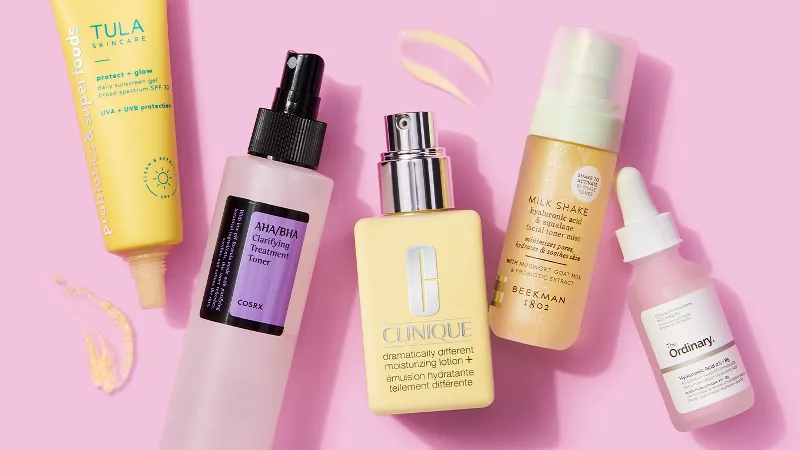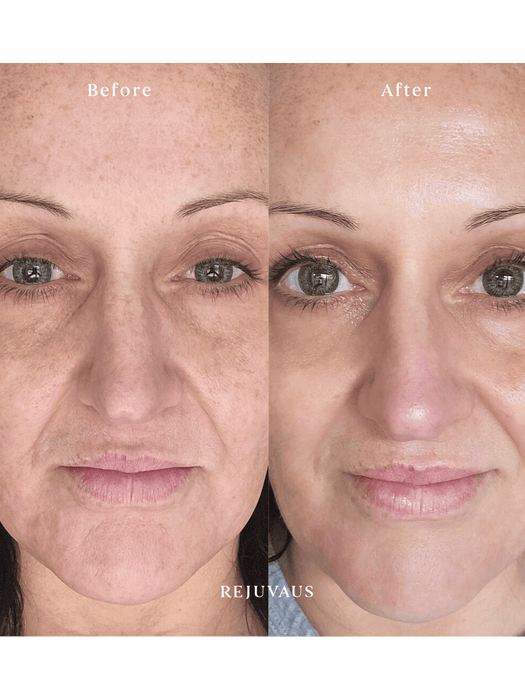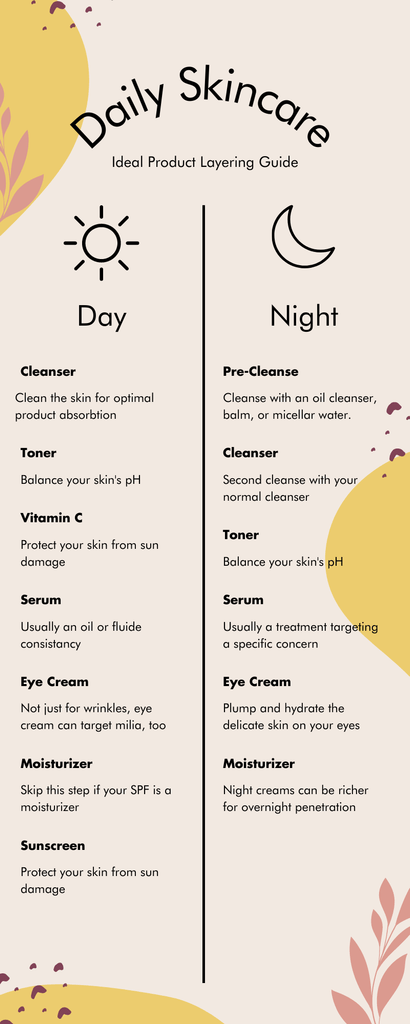Are you tired of feeling lost when it comes to taking care of your skin? You’re not alone.
Building a skincare routine that actually works can seem confusing and overwhelming. But imagine waking up every day knowing exactly what to do to keep your skin healthy, glowing, and refreshed. This guide is made just for you. By the end, you’ll have simple, clear steps to create a routine that fits your needs and lifestyle.
Ready to take control of your skin and boost your confidence? Let’s dive in.

Credit: www.youtube.com
Identify Your Skin Type
Understanding your skin type is the first and most important step in building a skincare routine that truly works for you. Your skin’s needs change depending on whether it’s oily, dry, normal, or sensitive. Identifying these traits helps you choose the right products and avoid issues like irritation or breakouts.
Normal Skin Traits
Normal skin feels balanced—not too oily or dry. It usually has a smooth texture with small pores and a healthy glow. If your skin rarely feels tight or greasy, you might have normal skin.
Do you notice your skin stays comfortable throughout the day without much shine or flakiness? That’s a strong sign of normal skin.
Oily Skin Signs
Oily skin produces extra sebum, which can make your face look shiny, especially in the T-zone (forehead, nose, and chin). You may also experience frequent breakouts or clogged pores.
Have you ever noticed your makeup sliding off midday or your skin feeling slick to the touch? Those are common signs of oily skin.
Dry Skin Features
Dry skin often feels tight and rough. You might see flaky patches or dullness, especially after washing your face. This skin type can be prone to redness and irritation.
Does your skin sometimes look cracked or feel uncomfortable without moisturizer? That’s typical for dry skin.
Combination Skin Characteristics
Combination skin is a mix—you might have an oily T-zone with dry or normal cheeks. This skin type requires careful balancing to address different needs in different areas.
Do you find yourself needing a mattifying product in some spots but a rich cream in others? Your skin could be combination.
Sensitive Skin Clues
Sensitive skin reacts easily to products or environmental factors with redness, itching, or burning. It often feels tight and uncomfortable after cleansing.
Have you noticed your skin flaring up after trying new skincare or being in harsh weather? These are clear signs of sensitive skin.
Essential Skincare Steps
Building a skincare routine means following key steps that keep your skin clean, balanced, and protected. Each step plays a vital role in maintaining healthy skin. Simple habits can lead to better skin over time.
Cleansing Basics
Cleansing removes dirt, oil, and impurities from the skin. Use a gentle cleanser that suits your skin type. Cleanse twice a day: morning and night. Avoid hot water to prevent dryness. Pat your face dry with a soft towel.
Toning Benefits
Toners help restore the skin’s natural pH balance. They prepare the skin to absorb moisturizers better. Look for alcohol-free toners with soothing ingredients. Apply toner with a cotton pad or your hands. This step refreshes and tightens the skin.
Moisturizing Tips
Moisturizers keep your skin soft and hydrated. Choose a moisturizer based on your skin type—light for oily, rich for dry. Apply moisturizer on slightly damp skin for better absorption. Don’t forget your neck and décolletage. Moisturizing prevents dryness and fine lines.
Sun Protection Importance
Sun protection is essential to prevent skin damage and aging. Use a broad-spectrum sunscreen with at least SPF 30 every day. Apply sunscreen 15 minutes before going outside. Reapply every two hours, especially after sweating or swimming. Protects skin from harmful UV rays and sunburn.
Choosing The Right Products
Choosing the right products is key to building a good skincare routine. The products must suit your skin and address your concerns. Picking the right ingredients helps your skin stay healthy and glowing. Avoiding harmful components protects your skin from damage. Product texture matters for comfort and effectiveness. Budget-friendly options keep your routine affordable and simple.
Ingredients To Look For
Choose products with gentle and effective ingredients. Some popular choices include:
- Hyaluronic acid for hydration
- Vitamin C to brighten skin
- Niacinamide to reduce redness and oil
- Salicylic acid for acne-prone skin
- Retinol to improve skin texture
These ingredients support skin health and target common problems.
Avoiding Harmful Components
Check product labels carefully. Stay away from:
- Alcohols that dry out skin
- Fragrances that cause irritation
- Parabens and sulfates that may harm skin
- Harsh exfoliants that damage skin barrier
Choosing safe products keeps your skin calm and balanced.
Product Texture And Skin Type
Match product texture to your skin type for best results:
- Oily skin: light gels or water-based lotions
- Dry skin: rich creams or oils
- Combination skin: balancing formulas
- Sensitive skin: fragrance-free, gentle textures
This helps your skin absorb products well without discomfort.
Budget-friendly Options
Good skincare does not need to be expensive. Many affordable products work well. Look for:
- Drugstore brands with proven ingredients
- Simple formulas with fewer additives
- Multi-use products that save money
- Trial sizes to test before buying full size
Smart choices keep your routine effective and budget-friendly.

Credit: drsakhiyas.com
Building Your Daily Routine
Building a daily skincare routine can feel overwhelming, but it doesn’t have to be complicated. The key is to create a simple flow that fits your lifestyle and addresses your skin’s needs consistently. Focus on basic steps that prepare and protect your skin, then add targeted treatments as you learn what works best.
Morning Skincare Flow
Your morning routine sets the tone for the day. Start with a gentle cleanser to remove any oil or sweat from the night. Follow with a lightweight moisturizer to hydrate without feeling heavy.
Don’t skip sunscreen—it’s the single most important step to prevent premature aging and skin damage. If you wear makeup, apply it after your moisturizer and sunscreen. Ask yourself: does my skin feel fresh and protected before I head out?
Nighttime Skincare Flow
At night, your skin needs repair and nourishment. Begin by thoroughly removing makeup and impurities with a cleanser suited to your skin type. Use a toner if you like, but only if it soothes or hydrates your skin.
Next, apply a serum or treatment that targets your specific concerns like acne, dryness, or fine lines. Finish with a richer moisturizer or night cream to lock in hydration while you sleep. Think about how your skin feels in the morning—does it wake up smooth or tight?
Weekly Treatments
Weekly treatments add an extra boost to your routine. Choose exfoliators to remove dead skin cells, but don’t overdo it—once or twice a week is enough for most skin types. Masks can address multiple issues: hydration, brightening, or calming redness.
Try scheduling these treatments on days when you have time to relax and let your skin absorb the benefits. Notice how your skin responds—does it glow or feel irritated? This feedback helps you adjust your routine for the best results.
Targeted Treatments For Common Concerns
Addressing specific skin concerns with targeted treatments can transform your skincare routine from basic to effective. Each skin issue demands a different approach, and knowing what works best for your unique needs saves you time and frustration. Let’s look at practical ways to tackle common problems like acne, aging, dullness, and dryness.
Acne Solutions
Acne requires products that reduce inflammation and clear clogged pores without over-drying your skin. Ingredients like salicylic acid and benzoyl peroxide work well to fight breakouts, but you need to balance them with gentle moisturizers to avoid irritation.
Have you noticed how your skin reacts to harsh acne treatments? Sometimes switching to a lightweight, non-comedogenic moisturizer can make a huge difference in managing flare-ups.
- Use a salicylic acid cleanser twice daily.
- Apply spot treatments with benzoyl peroxide on active blemishes.
- Don’t skip a non-comedogenic moisturizer to keep your skin barrier healthy.
Anti-aging Methods
Target fine lines and wrinkles by adding retinoids or peptides to your routine. These ingredients help boost collagen production and improve skin texture over time.
Consistency is key here—skipping days or using too much can cause redness and peeling. Start slow and listen to your skin’s response.
- Try a gentle retinol cream at night, gradually increasing frequency.
- Include peptide serums to support skin firmness.
- Always use sunscreen during the day to protect your progress.
Brightening Techniques
Dull skin can benefit from ingredients that promote cell turnover and even out skin tone. Vitamin C serums and exfoliating acids like glycolic acid brighten the complexion and reduce dark spots.
Have you tried layering a vitamin C serum under your moisturizer? It often gives a fresh glow without irritation if you pick the right formula.
- Apply vitamin C serum in the morning before moisturizer.
- Use a gentle exfoliant 1-2 times a week to slough off dead skin.
- Maintain hydration to keep skin looking vibrant.
Hydration Boosters
Dry, flaky skin signals a need for deeper hydration. Look for products containing hyaluronic acid, glycerin, or ceramides to lock in moisture and repair your skin barrier.
Don’t underestimate the power of a rich moisturizer after cleansing, especially in colder months. It keeps your skin smooth and prevents tightness.
- Apply a hydrating serum with hyaluronic acid on damp skin.
- Seal in moisture with a ceramide-rich cream.
- Consider overnight masks for an extra hydration boost.
Lifestyle Tips For Radiant Skin
Healthy skin starts with simple daily habits. Changing your lifestyle can improve your skin’s glow. Small shifts in diet, sleep, and stress levels make a big difference. These lifestyle tips help your skincare routine work better. Your skin reflects how you treat your body inside and out.
Healthy Diet Choices
Eat foods rich in vitamins and antioxidants. Colorful fruits and vegetables help fight skin damage. Include foods high in omega-3, like fish and nuts. Avoid too much sugar and processed foods. They can cause breakouts and dull skin. A balanced diet supports skin repair and hydration.
Hydration Habits
Drink plenty of water throughout the day. Water flushes out toxins and keeps skin soft. Aim for at least eight glasses daily. Herbal teas and water-rich fruits also help. Avoid sugary and caffeinated drinks that dry your skin. Proper hydration improves skin elasticity and brightness.
Sleep And Skin Health
Good sleep is essential for skin renewal. Aim for seven to eight hours every night. Lack of sleep causes dark circles and dull skin. During deep sleep, the body repairs skin cells. Create a calming bedtime routine to improve sleep quality. Rested skin looks fresh and youthful.
Stress Management
Stress affects your skin’s health and appearance. Find ways to relax and reduce stress daily. Try breathing exercises, meditation, or light exercise. Stress can cause inflammation and worsen skin conditions. Keeping calm helps your skin stay clear and balanced.
Tracking Progress And Adjustments
Tracking progress and making adjustments are key to building a skincare routine that truly works. Skin changes over time, so paying close attention helps improve results. Regular checks show what products benefit your skin and which may cause issues. This process prevents wasting time and money on ineffective products. It also helps avoid skin problems caused by wrong choices.
Monitoring Skin Changes
Observe your skin daily for changes in texture, tone, and hydration. Note any redness, dryness, or breakouts. Take photos weekly to compare progress visually. Keep a simple journal of how your skin feels each day. This record helps spot patterns and reactions to products. Patience is important; some products take weeks to show effects.
When To Switch Products
Switch products if your skin reacts negatively after two weeks. Signs include increased irritation, persistent redness, or new breakouts. Stop using any item that causes pain or swelling. If your skin shows no improvement after six to eight weeks, consider trying something new. Avoid changing too many products at once to identify causes easily.
Consulting A Dermatologist
Visit a dermatologist for persistent skin issues or unclear results. A professional can recommend treatments based on your skin type and concerns. They provide advice on safe product use and avoid harmful combinations. Dermatologists help manage conditions like acne, eczema, or rosacea effectively. Seek help early to prevent worsening skin problems.

Credit: www.youtube.com
Frequently Asked Questions
What Are The Basic Steps In A Skincare Routine?
A basic skincare routine includes cleansing, toning, moisturizing, and sunscreen application. These steps protect and nourish your skin daily, promoting a healthy complexion.
How Do I Choose Skincare Products For My Skin Type?
Identify your skin type—oily, dry, combination, or sensitive. Select products formulated specifically for your skin’s needs to achieve optimal results and avoid irritation.
How Often Should I Update My Skincare Routine?
Update your routine seasonally or when your skin changes. Adjusting products ensures your skin stays balanced and addresses new concerns effectively.
Can I Build A Skincare Routine On A Budget?
Yes, focus on essential products like cleanser, moisturizer, and sunscreen. Choose affordable, quality items that suit your skin without overspending.
Conclusion
Building a skincare routine doesn’t have to be hard. Start simple. Choose products that suit your skin type. Cleanser, toner, and moisturizer are essentials. Add sunscreen for daytime protection. Experiment with serums for specific needs. Always test new products on a small area first.
Consistency is key. Stick with your routine for the best results. Listen to your skin. Adjust your routine as needed. Stay patient. Changes take time. Your skin will thank you.




